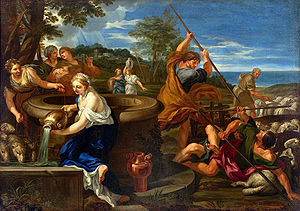Ciro Ferri

Ciro Ferri(1634 – 13 September 1689) was an ItalianBaroquesculptor and painter, the chief pupil and successor ofPietro da Cortona.
He was born inRome,where he began working under Cortona and with a team of artists in the extensive fresco decorations of theQuirinal Palace(1656–59). He collaborated with Cortona and completed for him the extensive frescoed ceilings and other internal decorations begun in thePitti Palace,Florence(1659–65). His independent masterpiece is considered an extensive series of scriptural frescoes in the church ofBasilica di Santa Maria Maggiore (Bergamo).Also well known is his an altarpiece ofSt Ambrose Healing the Sickin the church ofSant'Ambrogio della Massimain Rome.[1]
In 1670, he began the painting of the cupola ofSant'Agnese in Agonein central Rome, in a style recalling ofLanfranco'swork in the dome ofSant'Andrea della Valle;but died before it was completed in 1693 by his successorSebastiano Corbellini.
He executed also a large amount of miscellaneous designs, such as etchings and frontispieces for books; and served as an architect as well. Ferri was appointed to direct the Florentine students in Rome, and Gabbiani was one of his leading pupils. As regards style, Ferri ranks as chief of the grand manner of Cortona, also known as theMachinists movement,as opposed to the more sober and spare style promulgated byAndrea Sacchi,and continued byCarlo Marattaand others.[1]Among the many pupils and assistants wereAmbrogio Besozzi,Camillo Gabrielli,Marziale Carpinoni,Filippo Maria Galetti,Benedetto Luti,Giovanni Battista Marmi,Pietro Montanini,Giuseppe Nasini,Giovanni Odazzi,Tommaso Redi,andUrbano Romanelli.[2]
Ciro Ferri became a member of theAccademia di San Lucaon 3 June 1657. His ciborium for the high altar ofSanta Maria in Vallicellais a masterpieces of 17th-century bronze decorative sculpture. He continued under the patronage of the Medici, when together with the sculptorErcole Ferrata,Ferri the painter led the Medici Academy in Rome, established in 1673 by Grand DukeCosimo IIIof Tuscany. Among the pupils sent there from Florence wereAnton Domenico Gabbiani,Giovanni Battista Foggini,Atanasio Bimbacci,Carlo Marcellini,andMassimiliano Soldani Benzi[3] .
Ferri was also responsible for theReliquaryof the Arm ofSt. John the Baptistwhich is found in theSt John's Co-CathedralinMalta.Ciro Ferri contributed five illustrations to the missal ofPope Alexander VIIChigi, which was published in 1662. It also contained works by fellow artists in Rome, includingPietro da Cortona,Carlo Cesi,Guglielmo Cortese,Carlo Maratti,Jan Miel,Cornelis Bloemaert,andPier Francesco Mola.[4]
He died in Rome in 1689.
References
[edit]- This article incorporates text from a publication now in thepublic domain:Chisholm, Hugh,ed. (1911). "Ferri, Ciro".Encyclopædia Britannica.Vol. 10 (11th ed.). Cambridge University Press. p. 287.
- Web gallery of Art biography.
- Wittkower, Rudolph(1980).Art and Architecture Italy, 1600-1750.Penguin Books. pp. 328, 330.
Notes
[edit]- ^abChisholm 1911.
- ^Hobbes, James R. (1849).Picture collector's manual adapted to the professional man, and the amateur.London: T&W Boone. p. 87.
- ^By Giovanni Gaetano Bottari, Contributor Fratelli Pagliarini, Published 1766, Appresso Niccolò e Marco Pagliarini, Original from Oxford University Digitized Jan 31, 2007; page 190.
- ^17th Century Italian Drawings in the Metropolitan Museum of ArtBy Metropolitan Museum of Art (New York, N.Y.), Jacob Bean.
